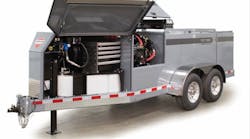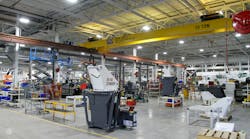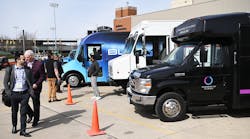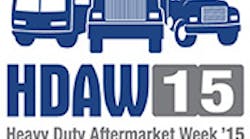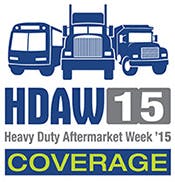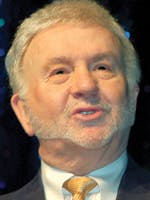HOW motivated are you?
Don Hutson, CEO of US Learning LLC, once was challenged by a person who claimed that motivation is of no value because it doesn’t last.
“A bath doesn’t either,” Hutson told him, “but it’s a good idea to take one once in awhile.”
In his presentation, “Elevate Your Sales with the High-Performance Edge,” Hutson said motivation makes the difference. He said Henry David Thoreau really nailed the concept of motivation when he called it “the pull of anticipation and the push of discipline.”
Attitude is another. He defined it as “the demeanor and spirit we choose to adopt and display from a given stimulus.”
“Working the HDAW trade show is challenging, trying to capture names and information,” he said. “It requires a can-do attitude to stay on top of things. How many people have noticed the marketplace has changed? You can’t sell like you used to. You have to be better than before.
“People change when the pain not to change exceeds the pain to change. If it hurts enough, we’re going to say, ‘I have to learn new skills on how to work a trade show and create a more engaging environment for a one-on-one with prospective buyers. I have to do things I’ve never done before. I have to have a hunger for knowledge and excitement for new information.’ ”
He said that the knowledge mass of the human race used to double every 50 years. But five years ago, he read a white paper that said it’s doubling every 5.2 years. And now, futurist John Nesbitt says that by 2025, it will double every 35 days.
“How many of you are going to be ready for that?” he asked. “We have to welcome change, be proactively opportunistic that our company will change, and capitalize on it rather than become a victim of it.
“We have to learn it for ourselves. How many of you have noticed in the heavy-duty aftermarket that everything doesn’t go perfectly? If it went perfectly, everybody and their brother would be in your business. You’ve got to go with the flow and do what you can to make a solid difference. You have to be skilled in goal-setting. There are no unrealistic goals—only unrealistic time frames, according to (real estate trainer) Jerry Bresser. Meaning that with enough time, we can make just about anything happen that we truly want to make happen. So can we be part of a stimulating vision that takes us to the next level? We can’t always do what we’ve done. Education is acquired by wisdom, intelligence, information, and data.”
Hutson said there’s a negative image of salesmen that goes way back, and the evolution of selling tells that story:
• The product pitch. It was mastered by the snake-oil salesman who sold products off the back of a wagon. The products had no medicinal value, so there were integrity issues, and the salesman had to move from town to town quickly.
• The hard sell. This came in the post-World War II years of the 1940s and lasted into the 1960s.
• Relationship selling. “In the early 1970s, a lot of smart sales people got together and said, ‘That hard sell stuff is not working. People don’t like to be hammered into a corner to make decisions before they’re ready. I’ve got a novel idea. Why not take them to lunch and ask them what they do? Let’s build some relationships.’ And it changed the entire landscape of American business. Organizations realized, ‘We’re in the business of serving others with integrity. And we do so by asking questions to determine what the best solution is for them.”
• Needs-analysis selling. “In the mid-1980s, we got really good at asking good questions, the answers to which revealed valuable information about their needs and wants.”
• Symbiotic selling. “It’s when you get so good with some of your prospects that you have a symbiotic relationship, and they not only have bought from you but have continue to. They don’t want to go into the marketplace without your expertise. Something dynamic happens. When we have a symbiotic relationship, we realize we’re doing such a great job addressing the needs of buyers that they don’t even want to talk to our competitors.”
He said that in professional selling today, interpersonal stress and personal trust are inversely proportional.
“If we try to hard-sell somebody today, the sales person tries to close the deal before he earns the right, and the stress of the prospect goes up and the trust goes down, and they say they’re not interested,” he said. “The best you can hope for is a lousy conversion rate and very long sales cycle.
“The desirable model is where stress is low, trust is high, while the conversion rate exceeds the sales cycle. Let’s build trust and create a symbiotic relationship. Let’s be so good that they don’t want to make decisions without our counsel. When trust is high and stress is low, the conversion rate is high and our sales cycle is shorter because we are efficient selling machines.
“The sales interaction dynamic is based on the idea that early on in the selling situation, years ago, sales people were features yakkers and did all the talking. Great sales people today say things like, ‘I’m excited to tell you about truck parts and all the capabilities we have, but before we get into that, I need to ask you some questions.’ People always say ‘yes’ to that, and that’s where we get needs analysis. The higher quality question we ask, the higher quality answer we get.
“Needs-analysis selling means leading with your ears. The good Lord gave us two ears and one mouth for an excellent statistical reason. I think He wanted us to listen more than we talk. Let’s ask well-crafted questions and take notes. That way we can get a competitive advantage all the way down the line.”
How to land new business:
• Locate. “Find out who’s on first, what’s on second, and what’s going on in the marketplace.”
• Approach. “We learn about people and initiate relationships and stage them for a follow-up.”
• Needs analysis. “And do all we can to make positive decisions.”
He said it’s important to be able to define the decision-making unit (DMU).
“That’s the specific individuals by name and title who are influencing the decision-making process,” Hutson said. “The more we know about the people in the DMU, the more people we can talk to and the more agendas we can access and can learn and understand how they make decisions in that organization. It usually begins with one good relationship—maybe one forged at a trade show.
“Dr George Lucas once said, ‘Some decision influencers might not be able to give you a definitive yes, but respect their position because they may well have veto power.’ ”
Hutson described differentiation as “the ways in which your offerings are different and superior to your competition.” He said unsophisticated marketers believe there are two types of differentiation: his products; and the price at which they’re offered.
The recommended strategy is that while commoditizing your offering, you need to differentiate it in every creative manner you can.
Leverage all seven types:
• Product. The definitive manner in which your offerings are superior to those of your competitors.
• Experiential. The exceptional manner in which we craft and perform unique customer experiences.
• Relationship. The means with which we utilize superior interpersonal skills to become a trusted advisor.
• Process. The unique methodology with which we do our work, resulting in exceptional performance for our clients.
• Technological. The means by which we deploy technology in an advanced and often unexpected way that favorably impresses our clients.
• Marketing. The exceptional sales, public relations, or promotional skill sets we deploy to help us win more business than our competition.
• Price. The degree to which our value proposition is more compelling than that of our competitors.
He provides some daily tactical sales activity recommendations:
• Four personally handwritten notes. “Everybody knows that but very few people do it anymore. It’s great for a trade show follow-up.”
• Three touch-base phone calls. “Maybe call a customer who used to be a customer and isn’t. Call them to touch base. Don’t ask them to buy anything. Just reacquaint with them and verify contact data.”
• Two new prospects every day.
• Learn one new thing daily. “Maybe it’s something about selling skills, maybe product knowledge, but learn something every day.”
• Allow no one to psyche you out. “Don’t let anybody quarterback you out of diligent thinking and perseverance.”
He said there are five Ps of articulating price: project your conviction; present your unique competitive advantage (UCA); presume credibility; protect your margin; and portray your brand.
The four strategies for increasing business: increase customer count; increase margin; increase average sale; and increase customer retention.
“It’s six times more expensive to get a new customer than to keep an existing one,” he said. ♦
